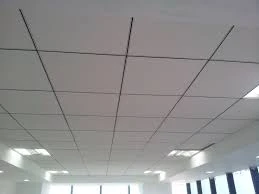9 月 . 28, 2024 11:11 Back to list
Ceiling Grid Cross Tee Installation Techniques and Best Practices for Precision монтаж
Understanding Ceiling Grid Cross Tees An Essential Component of Suspended Ceiling Systems
Ceiling grids are a fundamental aspect of modern architectural design, especially when it comes to suspended ceilings — a widely used technique in both commercial and residential buildings. Among the various components that make up these systems, cross tees play a vital role in supporting the ceiling panels and ensuring structural integrity. In this article, we will explore the significance of ceiling grid cross tees, their types, installation procedures, and benefits, ultimately highlighting their critical role in creating a functional and aesthetically pleasing ceiling.
What are Ceiling Grid Cross Tees?
Ceiling grid cross tees are horizontal components that intersect with main runners in a suspended ceiling grid. These elements enable the installation of ceiling tiles, panels, or other materials that form the visible surface of a suspended ceiling. Cross tees typically come in various lengths and are manufactured from materials such as galvanized steel or aluminum to ensure durability and resistance to environmental factors, such as humidity.
The Importance of Cross Tees
1. Structural Support Cross tees provide essential support to the ceiling panels, ensuring they remain level and secure. This structural integrity is crucial in preventing sagging or bowing over time, which can impact both aesthetics and safety.
2. Design Flexibility By incorporating cross tees, designers can create various ceiling configurations, including squares, rectangles, and custom layouts. This flexibility allows for innovative designs that enhance the overall architectural appeal of a space.
3. Easy Access to Infrastructure Suspended ceilings with cross tees allow easy access to the building's infrastructure, such as HVAC ducts, wiring, and plumbing. This accessibility makes maintenance and repairs more straightforward, reducing downtime and costs.
4. Acoustic Performance Many ceiling panels are designed with acoustic properties to absorb sound. Cross tees contribute to this performance by providing a stable framework that complements the design and functionality of acoustic tiles, thereby improving the overall sound quality within a room.
Types of Cross Tees
Cross tees come in various types to accommodate different ceiling designs and specifications
- Standard Cross Tees These are the most common type, typically available in lengths of 24 inches or 48 inches, and are compatible with most suspended ceiling systems.
ceiling grid cross tee

- Longitudinal Tees These are longer cross tees that can span wider distances, providing additional versatility in large open spaces.
- Architectural Cross Tees Designed for more complex ceiling configurations, architectural cross tees may feature decorative elements or unique shapes that enhance the aesthetic appeal of a space
.Installation of Cross Tees
The installation of ceiling grid cross tees is a critical step in the suspended ceiling process. Here’s a step-by-step guide
1. Planning Prior to installation, it is essential to plan the layout of the ceiling grid, including the placement of main runners and cross tees. Considerations such as the height of the ceiling and the size of the tiles must be taken into account.
2. Hanging the Main Runners Main runners are first secured to the ceiling using appropriate anchoring methods, creating a framework for the grid system.
3. Adding Cross Tees Once the main runners are in place, cross tees are inserted into the slots on the main runners. The placement should correspond to the size of the ceiling panels that will be installed.
4. Leveling and Securing After laying all the cross tees, it is essential to ensure they are level. This may require adjustments before securing them properly with clips or fasteners.
5. Installing Ceiling Panels Finally, ceiling panels are installed into the grid system, completing the suspended ceiling.
Conclusion
Ceiling grid cross tees play an indispensable role in the construction and functionality of suspended ceilings. They not only ensure structural stability and support for ceiling panels but also enhance design flexibility and acoustic performance. Understanding the types and installation of cross tees is essential for anyone involved in construction or renovation projects. By recognizing their importance, builders and designers can create spaces that are both functional and aesthetically pleasing, meeting the diverse needs of modern architecture.
-
Revolutionizing Interior Design with Ceilings t grid Suspended SystemNewsOct.29,2024
-
Revolutionizing Ceiling Design with ceiling access panel with Gypsum Tile WaterproofNewsOct.29,2024
-
Revolutionizing Interior Design with PVC Gypsum Ceiling: A Comprehensive GuideNewsOct.29,2024
-
Elevating Interior Design with High quality Mineral Fiber Ceiling TilesNewsOct.29,2024
-
Revolutionizing Interior Design with PVC Gypsum Ceiling: A Comprehensive GuideNewsOct.29,2024
-
Elevating Interior Design with High-Quality Mineral Fiber Ceiling Tiles: A Comprehensive GuideNewsOct.29,2024







